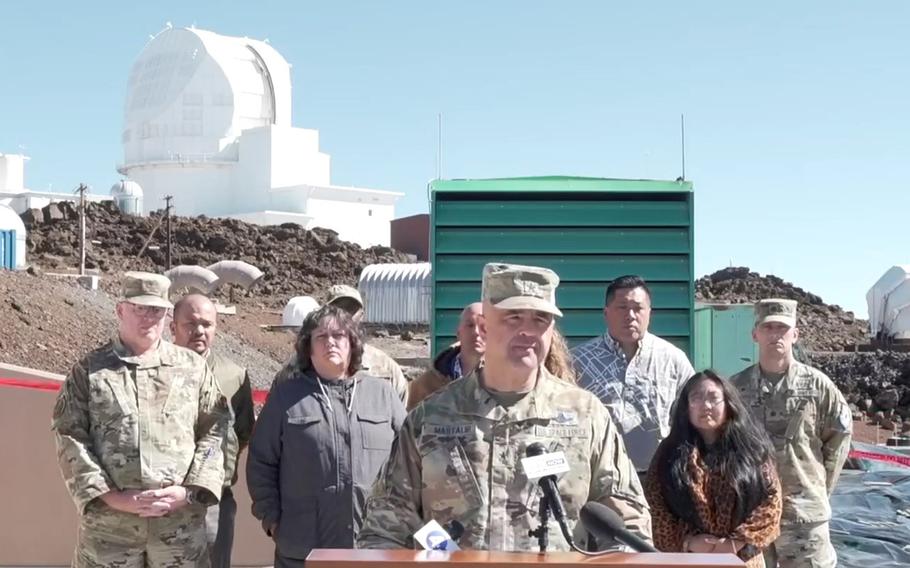
Brig. Gen. Anthony Mastalir, commander of U.S. Space Forces Indo-Pacific, speaks to reporters at the Maui Space Surveillance Complex, Hawaii, on Feb. 6, 2023. (Defense Media Activity Pacific)
FORT SHAFTER, Hawaii — A vast amount of contaminated soil must be removed after a catastrophic storage tank failure last week saturated the ground with diesel fuel at a mountaintop observatory on Maui operated by U.S. Space Forces Indo-Pacific, its commander said Monday.
Workers will remove 200 cubic yards of soil to a depth of 6 feet, Brig. Gen. Anthony Mastalir said during a news conference at the Maui Space Surveillance Complex, where the spill occurred on Jan. 29.
At that point, samples will be taken to assess how much more soil will need to be removed, he said.
“Right now, it’s impossible to know how deep we will need to go,” Mastalir said.
All soil will be cleansed of fuel residue and then laid back in the ground.
Several telescopes in the complex atop the 10,000-foot summit of Haleakala, a dormant volcano, are used to track satellites and space debris.
The diesel fuel powers a backup generator needed during power outages, such as during storms, Mastalir said.
Maintenance personnel discovered the spill on the morning of Jan. 30.
“We have examined the fuel storage tank and the generator equipment,” Mastalir said. “We currently assess that the cause of this spill was the damaged float within the generator’s main fuel tank. Specifically, the evidence suggests that a power surge was the likely cause of this damage.”
He likened the operation of the float to that of a household toilet bowl.
“When the fuel drops to a certain level, the float calls for more fuel,” he said. It should then signal the transfer pump to shut off.
Furthermore, the float is designed to set off an alarm warning in event of a potential overflow.
“This float failed in a way so that that never happened,” he said, reiterating that it “failed catastrophically.”
Flanked by uniformed and civilian personnel who are assisting in the assessment and planning for remediation, Mastalir apologized profusely and repeatedly during the brief news conference.
“I want to express my sincere apologies for what happened here one week ago today,” he said.
“Words cannot describe the tremendous remorse that I, and the rest of the team on the summit, have experienced over this past week. We have a solemn responsibility to protect this sacred ground upon which we have the privilege to operate. And it is a privilege, not a right.”
The leak came at a time when many in Hawaii are fed up with military snafus.
A fuel leak on Oahu from the Navy’s World War II-era Red Hill underground fuel storage facility in late 2021 contaminated drinking water for thousands of residents living in military communities on and near Joint Base Pearl Harbor-Hickam.
In the fall, while Navy officials were preparing to drain the Red Hill tanks for the site’s permanent closure, a toxic firefighting foam was accidently released at the facility.
On Friday, the Hawaiian rights group Kākoʻo Haleakalā called for the removal of all telescopes from the peak of Haleakala.
The military “showcased their incompetence and lack of human decency when they allowed more than 700 gallons of diesel fuel to be spilled atop Haleakalā,” the group said in a statement.
“This is just the most recent example of how U.S. imperialism and military hegemony is protected in the Pacific while Hawaiians are ignored and our ʻāina is violated,” the statement said, using the Hawaiian term for land.
Mastalir said he had been meeting with local groups and elected officials during the past week to assuage their concerns.
He pledged to promote openness and transparency during the cleanup process and to “develop remediation a plan that is consistent with legal requirements and sensitive to the local and cultural imperatives.”